Search code, repositories, users, issues, pull requests...
System design is often taught through domain-specific solutions specific to particular domains, such as databases, operating systems, or computer architecture, each with its own methods and vocabulary. While this diversity is a strength, it can obscure cross-cutting principles that recur across domains. This paper proposes a preliminary “periodic table” of system design principles distilled from several domains in computer systems. The goal is a shared, concise vocabulary that helps students, researchers, and practitioners reason about structure and trade-offs, compare designs across domains, and communicate choices more clearly.
One of the rewards of working in computer systems is the field’s sheer diversity, spanning operating systems, databases, computer architecture, distributed systems, programming languages, networking, and more, each with a rich history. For newcomers, it can be challenging to spot connections across different domains due to the diversity of traditions and vocabularies: the same design principle may appear in different guises across domains.
For example, consider the classic paper on database isolation levels by Jim Gray et al. [17]. It offers a careful account of concurrency-control mechanisms and the trade-offs between correctness and performance. Yet without prior exposure to similar issues in operating systems or computer architecture, the ideas can appear narrowly “about databases.” In reality, the same design principle, "relaxation of consistency," reappears across systems in different guises, from weakly ordered memory hierarchies to eventual-consistency protocols. When each community uses its own terms and exemplars, newcomers may find it difficult to recognize the underlying design principles. This fragmentation increases cognitive overhead, as the same trade-off must be relearned in each context.














